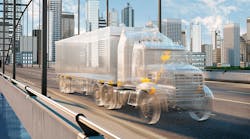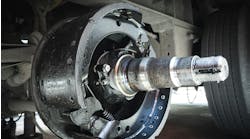How tire monitoring cuts roadside calls and increases tire TCO
It’s no secret that an underinflated tire can initiate a financially painful domino effect in a fleet’s operations. Low psi creates weak spots in a tire’s sidewall and over time increases the likelihood of a blowout. That in turn waylays the truck which must wait for emergency roadside assistance. By now, the losses are approaching four figures.
“You not only have to pay for the cost of replacing the tire, you have to pay for somebody to come out there and service the vehicle,” noted Sam Brackett, Continental Tire’s digital solutions manager for the Americas, on a recent Fleet Maintenance webchat. “You're losing opportunities; when the truck's not running, you're not making money.”
Watch: Rolling into the future: Increasing uptime with next generation digital tire monitoring and retreading
Customer dissatisfaction, frustrated drivers, and negative brand perception (if your logo is emblazoned on the side of the trailer) are other less quantifiable, but equally important costs to consider.
And that’s just the start. A tire underinflated by 10 psi will reduce casing life by 15% and tread life by 10%, while also decreasing fuel efficiency, Brackett noted.
According to the American Trucking Associations Technology & Maintenance Council, a tire continuously underinflated by 20% reduces its life by 30%, while 40% cuts it by 50%.
Not being able to retread a tire itself can cost a fleet $350 per tire.
“Let's say a new drive tire could cost roughly around $500; a retread could be as low as a third of that cost, so maybe 150 bucks,” noted Bridney Jordan, Continental’s product marketing manager of truck tires for North America.
And tires can be retread three times, equaling four lifecycles per tire.
“If you think about cost over time, that is a huge benefit,” Jordan said.
Read more: Pumping up TPMS and ATIS maintenance practices
In total, Continental estimates tires impact more than 27% of a fleet's operating costs. This includes 20% for fuel and additives, 5% for maintenance and repair, 2% directly for tires, and then tack on any costs for breakdowns and unplanned maintenance.
The fuel data used was from 2010-2020, so in times that diesel costs more than $5, like now, the fuel efficiency aspect is even more costly.
“We know fuel costs are going through the roof and that's becoming [a] bigger and bigger part of a fleet's expense right now,” Brackett continued. “Properly inflated tires can save 1% on fuel costs over the course of a year.”
That adds up to a lot of savings throughout the year, up to $800 per truck. The problem is that Continental found in a study involving 1 million tires, 35% were underinflated by 10 psi.
The need for tire monitoring
Continental’s advice is to deploy a monitoring solution. They provide ContiConnect 2.0, a brand-agnostic array of products that generates data from tire sensors (installed inside the tire) and alert fleets to potential issues with tire pressure and temperature. Brackett also noted that in early 2023, Continental will launch a sensor that measures an individual tire’s mileage.
“And we're working on future functionalities that will also allow that sensor to have some predictive tread depth measures,” he added.
The solution can also scale to whatever a fleet needs. The ContiConnect Yard reader, for example, can be positioned at common terminal touch points and automatically pull tire data from any truck and feed that to the backend. Anyone with access to the web portal can see that tire data and identify underinflated tires before they blowout, or tires that are so worn they cannot be retread.
Another option is to start small and trial the tire pressure monitoring solution on steer tires. That’s one Brackettsaid one fleet did. This fleet, he explained, was seeking to lower its roadside call expense, which reached $400,000 in one year.
“They implemented our solution just on the steer tires of their fleet that was at one depot,” he said. “And they didn't see any issues at that single depot for the first quarter.”
The fleet then adopted the technology on 95% of their trucks.
“They've reduced their emergency roadside cost to almost nothing—zero related to tires,” Brackett said.
Fleets can pilot the program for a few months, he added, which he is confident will show that digital monitoring is a far better method than tire thumping.
Another tire solution provider, Aperia Technologies, found that 17% of truck drivers don’t correctly measure psi, while half don’t know what the correct tire pressure should even be.
Judith Monte, head of marketing and customer experience at Aperia, said the company asked drivers to test out the tire thumping method and the results were inconsistent. She advised that fleets at least invest in digital tire gauges.
“It's hard for even the very best trained and the best performing drivers to just manually manage something that's so important,” Monte said.




